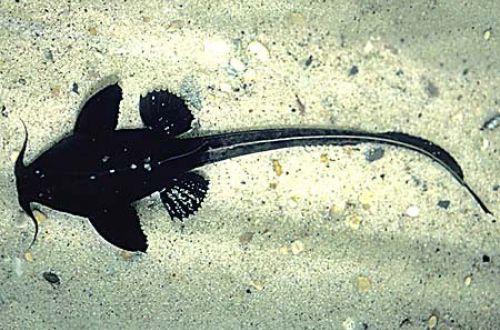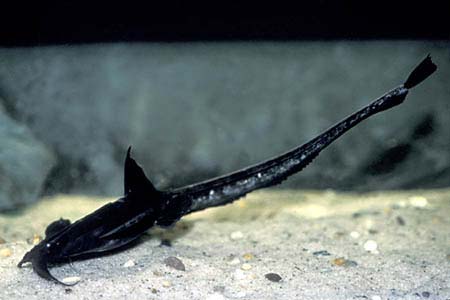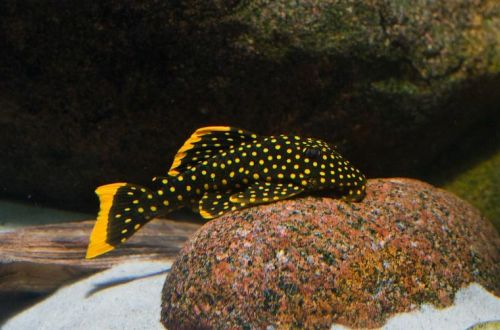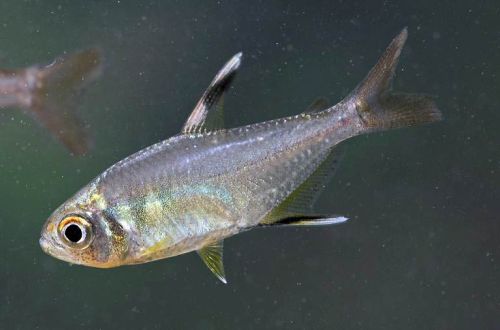
Striped banjo catfish
The striped banjo catfish, scientific name Platystacus cotylephorus, belongs to the Aspredinidae family. The fish is native to South America. It is found on the eastern tip of the continent in French Guiana, Guyana, Suriname, Venezuela, Brazil, and also on the island nation of Trindade and Tobago. Inhabits estuaries, deltas and coastal brackish waters where rivers flow into the ocean. It is widely distributed in mangroves, where it hides buried in silt.

Description
Quite a large catfish, reaching more than 30 cm in length. The fish got its name because of the similarity of the body shape to the Banjo musical instrument, which has a large body and a long thin neck. Catfish, in turn, has a flattened oval-shaped body and a long, thin tail.
The pectoral and ventral fins are wide, fan-shaped, located along the narrow body and, when viewed from above, increase the size of the fish. The tail is short, resembles a brush. The dorsal fin is also short and triangular in shape.

The entire body is covered with bony plates that protect against the teeth of predators. In addition, the first rays of the fins have changed into sharp spikes.
The eyes are very small and located on the top of the head. They are not designed to search for food, the catfish relies on smell and touch, but are needed to look out for predators.
The coloration is almost black with a light narrow stripe along the body.
Behavior and Compatibility
Peaceful calm look. It gets along well with relatives, as well as other fish of a comparable size. For example, viviparous fish, cichlids from Central America, Rainbowfish and others will be good neighbors in a freshwater aquarium. A successful neighborhood is observed with many brackish water fish, for example, with not the most accommodating gobies.
Due to its omnivorous nature, it can, on occasion, eat a small fish, a fry.
Leads a hidden life. It is active only at night. During the day, it prefers to hide in shelters or, if possible, burrow into soft, silty ground. Often almost does not move, disguising itself as a fallen leaf, a snag.
For slow movement, it often uses an unusual method – it pushes water through the gills, creating a small jet movement, reminiscent of a driftwood or leaf rolling along the bottom with current or waves.
Brief information:
- The volume of the aquarium – from 150 liters.
- Temperature – 22-25°C
- Value pH — 6.0–8.2
- Water hardness – medium or high hardness
- Substrate type – soft sandy
- Lighting – subdued
- Brackish water – no
- Water movement is weak
- The size of the fish is up to 32 cm.
- Nutrition – foods rich in protein
- Temperament – peaceful
Maintenance and care, arrangement of the aquarium
The optimal dimensions of the aquarium are about a meter in width or length and a small height. For catfish, bottom area is more important than depth. The minimum volume can be about 150 liters, which is quite enough for such a sedentary fish.
The design requires several places for shelters of a suitable size: branches, snags, large leaves, such as beech. The soil is soft sandy. Keeping only one Striped Banjo Catfish can create low lighting.
Catfish does not feel well in soft acidic water. It is recommended to maintain water parameters of medium hardness and pH values around a neutral or slightly alkaline mark.
The addition of salt is optional, but it can be stored under brackish conditions if desired.
Food
Prefers food rich in protein, such as fresh, frozen or live bloodworms, earthworms. You can diversify the diet with dry sinking flakes, granules.
Serve in the evening before turning off the lights.
Sources: fishbase.se, seriouslyfish.com





